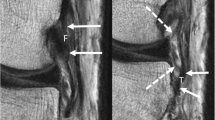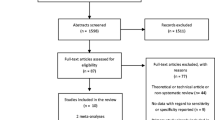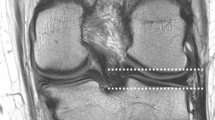Abstract
Purpose
The purpose of this study was to assess the sensitivity and specificity of 1.5 T magnetic resonance imaging (MRI) in diagnosing and identifying the specific injury pattern in patients with knee dislocation. The hypothesis was that the sensitivity and specificity are low in patients with posterolateral corner injury and/or PCL tear.
Methods
A retrospective study was performed on 38 patients (m:f = 29:9, mean age ± SD 34.3 ± 14.0) with traumatic knee dislocation, who underwent 1.5 T MRI prior to surgery. MRI scans were analysed by a musculoskeletal radiologist, and the presence and type of tears to ligaments, tendons and meniscus or bone were recorded. Comparison was made with the intraoperative findings from the surgical records using the same reporting scheme. The agreement between MRI and surgical findings was assessed using kappa statistics, and the sensitivity and specificity were calculated.
Results
In patients with knee dislocation, MRI was found to have low sensitivity (25–38 %) but high specificity (94–97 %) for diagnosing injury to the posterolateral corner. There was high sensitivity in the diagnosis of tears in the cruciate and collateral ligaments (97–100 %); the specificity, however, was lower (50–67 %). The diagnosis of meniscal injury showed low sensitivity (36–56 %) and moderate specificity (69–83 %).
Conclusions
MRI is a sensitive measure of cruciate and collateral ligament injury in acute knee dislocation; however, it does not reliably diagnose injury to the posterolateral corner or meniscus, and therefore, a higher index of suspicion is required during arthroscopy to prevent misdiagnosis which could affect long-term clinical outcome.
Level of evidence
Diagnostic study, Level II.



Similar content being viewed by others
References
Barbier O, Galaud B, Descamps S, Boisrenoult P, Leray E, Lustig S, Bonnevialle P, Laffargue P, Paillot JL, Rosset P, Neyret P, Saragaglia D, Lapra C, French Society of Orthopaedic S, Traumatology (2013) Relevancy and reproducibility of magnetic resonance imaging (MRI) interpretation in multiple-ligament injuries and dislocations of the knee. Orthop Traumatol Surg Res 99:305–311
Chen W, Zhao J, Wen Y, Xie B, Zhou X, Guo L, Yang L, Wang J, Dai Y, Zhou D (2015) Accuracy of 3-T MRI using susceptibility-weighted imaging to detect meniscal tears of the knee. Knee Surg Sports Traumatol Arthrosc 23:198–204
Crawford R, Walley G, Bridgman S, Maffulli N (2007) Magnetic resonance imaging versus arthroscopy in the diagnosis of knee pathology, concentrating on meniscal lesions and ACL tears: a systematic review. Brit Med Bull 84:5–23
De Smet AA, Graf BK (1994) Meniscal tears missed on MR imaging: relationship to meniscal tear patterns and anterior cruciate ligament tears. AJR Am J Roentgenol 162:905–911
Delin C, Silvera S, Coste J, Thelen P, Lefevre N, Ehkirch FP, Le Couls V, Oudjit A, Radier C, Legmann P (2013) Reliability and diagnostic accuracy of qualitative evaluation of diffusion-weighted MRI combined with conventional MRI in differentiating between complete and partial anterior cruciate ligament tears. Eur Radiol 23:845–854
Halinen J, Koivikko M, Lindahl J, Hirvensalo E (2009) The efficacy of magnetic resonance imaging in acute multi-ligament injuries. Int Orthop 33:1733–1738
Hirschmann MT, Iranpour F, Muller W, Friederich NF (2010) Surgical treatment of complex bicruciate knee ligament injuries in elite athletes: what long-term outcome can we expect? Am J Sports Med 38:1103–1109
Hirschmann MT, Zimmermann N, Rychen T, Candrian C, Hudetz D, Lorez LG, Amsler F, Muller W, Friederich NF (2010) Clinical and radiological outcomes after management of traumatic knee dislocation by open single stage complete reconstruction/repair. BMC Musculoskelet Disord 11:102
Howells NR, Brunton LR, Robinson J, Porteus AJ, Eldridge JD, Murray JR (2011) Acute knee dislocation: an evidence based approach to the management of the multiligament injured knee. Injury 42:1198–1204
Karantanas AH (2014) What’s new in the use of MRI in the orthopaedic trauma patient? Injury 45:923–933
Lafferty PM, Min W, Tejwani NC (2009) Stress radiographs in orthopaedic surgery. J Am Acad Orthop Surg 17:528–539
LaPrade RF, Ho CP, James E, Crespo B, LaPrade CM, Matheny LM (2015) Diagnostic accuracy of 3.0 T magnetic resonance imaging for the detection of meniscus posterior root pathology. Knee Surg Sports Traumatol Arthrosc 23:152–157
LaPrade RF, Resig S, Wentorf F, Lewis JL (1999) The effects of grade III posterolateral knee complex injuries on anterior cruciate ligament graft force. A biomechanical analysis. Am J Sports Med 27:469–475
Lefevre N, Naouri JF, Bohu Y, Klouche S, Herman S (2014) Sensitivity and specificity of bell-hammer tear as an indirect sign of partial anterior cruciate ligament rupture on magnetic resonance imaging. Knee Surg Sports Traumatol Arthrosc 22:1112–1118
Lonner JH, Dupuy DE, Siliski JM (2000) Comparison of magnetic resonance imaging with operative findings in acute traumatic dislocations of the adult knee. J Orthop Trauma 14:183–186
McKee L, Ibrahim MS, Lawrence T, Pengas IP, Khan WS (2014) Current concepts in acute knee dislocation: the missed diagnosis? Open Orthop J 8:162–167
Medina O, Arom GA, Yeranosian MG, Petrigliano FA, McAllister DR (2014) Vascular and nerve injury after knee dislocation: a systematic review. Clin Orthop Relat Res 472:2621–2629
Munshi M, Davidson M, MacDonald PB, Froese W, Sutherland K (2000) The efficacy of magnetic resonance imaging in acute knee injuries. Clin J Sport Med 10:34–39
Nam TS, Kim MK, Ahn JH (2014) Efficacy of magnetic resonance imaging evaluation for meniscal tear in acute anterior cruciate ligament injuries. Arthroscopy 30:475–482
Odgaard F, Tuxoe J, Joergensen U, Lange B, Lausten G, Brettlau T, Thomsen HS (2002) Clinical decision making in the acutely injured knee based on repeat clinical examination and MRI. Scand J Med Sci Sports 12:154–162
Park HJ, Kim SS, Lee SY, Park NH, Ahn JH, Chung EC, Park JY, Kim MS (2014) Comparison between arthroscopic findings and 1.5-T and 3-T MRI of oblique coronal and sagittal planes of the knee for evaluation of selective bundle injury of the anterior cruciate ligament. AJR Am J Roentgenol 203:W199–W206
Potter HG, Weinstein M, Allen AA, Wickiewicz TL, Helfet DL (2002) Magnetic resonance imaging of the multiple-ligament injured knee. J Orthop Trauma 16:330–339
Ramnath RR, Magee T, Wasudev N, Murrah R (2006) Accuracy of 3-T MRI using fast spin-echo technique to detect meniscal tears of the knee. AJR Am J Roentgenol 187:221–225
Sampson MJ, Jackson MP, Moran CJ, Shine S, Moran R, Eustace SJ (2008) Three Tesla MRI for the diagnosis of meniscal and anterior cruciate ligament pathology: a comparison to arthroscopic findings. Clin Radiol 63:1106–1111
Schub DL, Altahawi F, Meisel AF, Winalski C, Parker RD, Saluan PM (2012) Accuracy of 3-Tesla magnetic resonance imaging for the diagnosis of intra-articular knee injuries in children and teenagers. J Pediatr Orthop 32:765–769
Swenson TM (2000) Physical diagnosis of the multiple-ligament-injured knee. Clin Sports Med 19:415–423
Turner DA, Prodromos CC, Petasnick JP, Clark JW (1985) Acute injury of the ligaments of the knee: magnetic resonance evaluation. Radiology 154:717–722
Twaddle BC, Bidwell TA, Chapman JR (2003) Knee dislocations: where are the lesions? A prospective evaluation of surgical findings in 63 cases. J Orthop Trauma 17:198–202
Twaddle BC, Hunter JC, Chapman JR, Simonian PT, Escobedo EM (1996) MRI in acute knee dislocation. A prospective study of clinical, MRI, and surgical findings. J Bone Joint Surg Br 78:573–579
Walker RE, McDougall D, Patel S, Grant JA, Longino PD, Mohtadi NG (2013) Radiologic review of knee dislocation: from diagnosis to repair. AJR Am J Roentgenol 201:483–495
Author information
Authors and Affiliations
Corresponding author
Rights and permissions
About this article
Cite this article
Derby, E., Imrecke, J., Henckel, J. et al. How sensitive and specific is 1.5 Tesla MRI for diagnosing injuries in patients with knee dislocation?. Knee Surg Sports Traumatol Arthrosc 25, 517–523 (2017). https://doi.org/10.1007/s00167-015-3857-4
Received:
Accepted:
Published:
Issue Date:
DOI: https://doi.org/10.1007/s00167-015-3857-4




